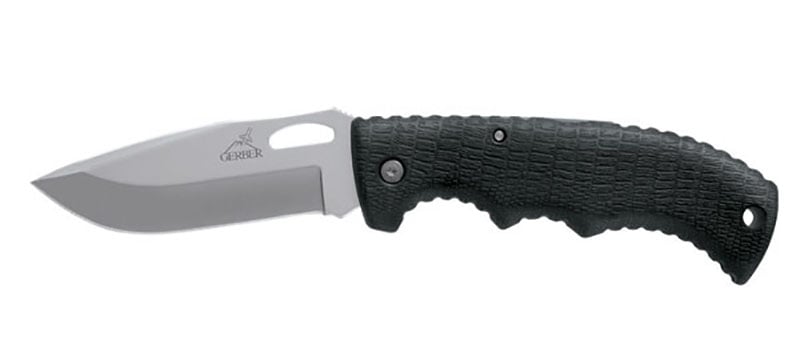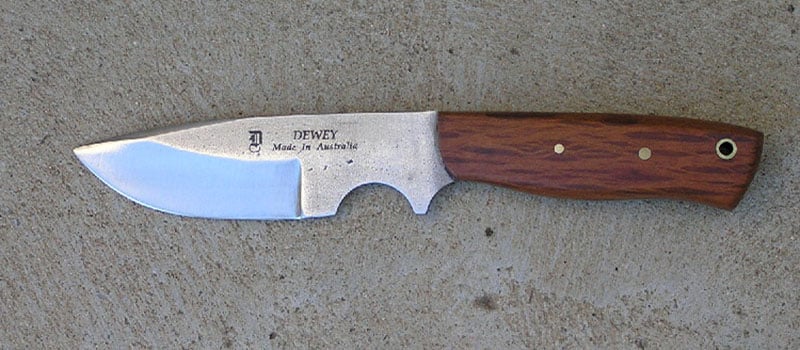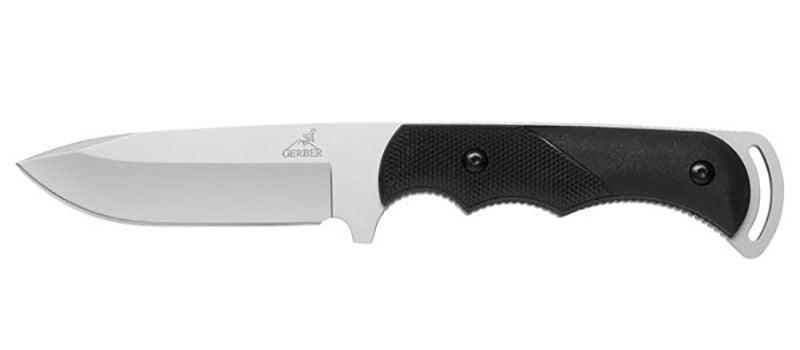Last Updated on
By David Link
Tackling your favorite stretch of hunting territory or heading off on a multi-day hike or camping trip? One tool you should never leave behind is a sharp, reliable knife. From field dressing that trophy buck to acting as a survival tool in sticky situations, if you’re an outdoorsman or woman and you don’t own a quality knife, well then shame on you. Before you head out into the field again, it’s time to pick up a knife that you can trust. But what qualities does a desirable outdoor knife have? Not to worry, we’ll walk you through the important factors involved in selecting a knife you can trust to get the job done. We’re going to divide this search into two parts: hunting knife and survival /general outdoor knife. But first, a little on fixed blade vs. folding knives and how that will impact your search.
Fixed Blades Or Folding Blades?
Fixed blade knives consist of one solid piece of metal that includes the entire blade and at least a significant portion of the handle. This can be either a full tang or a partial tang. Tang is the portion of the knife that extends into the handle and helps provide support for the blade portion. Full tangs extend all the way to the end of the knife handle and the strongest full tang knives also extend the full width of the handle. This means that even if the wood, plastic, or other material that covers the tang is lost that the full tang knife will still be usable in an emergency. Partial tangs do not extend all the way to the end of the handle, but they still provide some level of support for the blade portion. These designs are sometimes known as rat tail tangs or stick tangs, and they represent a cheaper option because less steel is used in construction. If you want an extremely strong blade, full tang knives are always the best choice. The drawback of fixed blade knives is that they require much more space to transport (for example along your belt), and a sheath for the knife is always the safest option.
Folding blades are best described as the pocket knives we’re all familiar with in some regard. When closed, the blade is protected by the handle of the knife, and when extended the blade is held in place by means of a locking mechanism. These days lock blade knives are the most popular folding blade designs and once extended the blade remains in place until a lever or portion of steel in the handle is pressed thereby releasing the blade so it can be folded back up. The advantages of a folding blade are obvious, particularly the ability to transport the knife easily without requiring much space. Yet a folding blade knife will never be as strong as a fixed blade knife because a single piece of steel does not extend into the handle.
Hunting Knife
A hunting knife must really focus on one purpose. Hunting knives are designed to field dress game, plain and simple, and although it’s common for hunters to use them for other purposes, field dressing is the primary purpose to focus on. If you want to cut branches around your treestand for example, you should consider a small saw for the purpose over trying to force your hunting knife to handle the task. Once you’ve shot and tracked the deer or other animal you’ve been hunting, it’s time to break out the hunting knife and get to work. But what qualities make up a good hunting knife?
First and foremost, hunting knives need to be somewhat nimble. They have to skirt around organs and make cuts where you’ll not have much extra clearance to work with. Most agree that ideal hunting knives are between 3 and 4 inches in length, but they should never exceed 4 inches. When it comes to differentiating between a fixed and folding blade for the purpose, either design works as long as the fixed blade isn’t too long. Aside from the occasional bone splitting action required in field dressing, the strength of a folding blade knife should be more than adequate for any field dressing task. There is some concern about those who climb treestands and wear a fixed blade knife in a sheath on their belt, but a high quality sheath should mitigate most of the concern.

As for the type of blade tip, two types generally stand out as the best for field dressing. The first is a skinning knife specifically designed for the job of field dressing. Its wide-ranging blade is perfect for the task, and it can also aid in further skinning and quartering of the animal once you get it back home. The other, slightly less specialized blade tip to use as a hunting knife is the drop point tip. It still provides some of the extra surface area found in skinning knives, and the tip reduces the chance of puncturing organs while you’re making initial incisions.

Survival / General Outdoor Knife
A survival knife has many qualities that are not ideal in a hunting knife, but in a pinch, a survival knife should still be able to handle skinning and field dressing. This is not to say that it will be the most precision job ever, but when you’re hungry, you can’t complain too much. Other activities that you may need to tackle with a survival knife include splitting and shaving wood for fires (typically small to medium branches), acting as a fire starting tool, serving as a first aid tool in emergencies, filling in as a shovel or hammer, and even assisting in hunting or self-defense actions. For all these reasons, there is only one type of knife that is worth selecting for the job: a fixed blade knife with a full tang that is as wide as the handle. Even better is an extended tang so you can handle the hammering tasks without risking damage to the blade. Extended tangs protrude from the end of the handle and offer a flat piece of steel that can aid in a variety of tasks that blades won’t.

When it comes to blade and tip styles, a straight edged blade will work best for the purpose, but just make sure it is a one sided blade. A double-sided blade won’t allow for pressing down on the flat edge of the blade required in some tasks. As for tip style, the drop point we outlined in hunting knives is the best point for a survival knife as well. Finally, when it comes to blade length, anywhere between 4 and 8 inches is generally regarded as a suitable length. It can still be used for skinning techniques, but its fixed blade and extended tang make it versatile enough for other tasks.
If you’ve haven’t guessed it already, there’s actually an all in one solution. A 4 inch fixed blade knife with a drop point tip and a straight edged blade will act as a suitable option for both purposes. However if you’re on a budget, a folding knife with a drop point tip will serve just fine as a hunting knife. If you’re survival focused, you may decide to go with a little longer fixed blade knife just to ensure you’ve got enough room for tasks like splitting branches and self-defense. Whatever you do, just make sure you keep your knife extremely sharp anytime you head out.
Skinning knife image courtesy of Wikimedia Commons.











